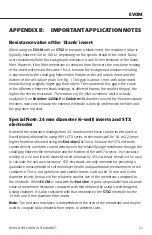
it touches the bottom
of the dish each time,
the reproducibility of
the measurements is
significantly improved.
Even small differences
in the apparent fluid
resistance may occur
if the depth to which
the electrode tips are
immersed varies.
Place the electrode into
the well so the tips just
touch the bottom of the
wells
without flexing
the electrode.
To obtain
reproducible results in the
same cup, the position
of the electrodes must remain constant. To improve the reproducibility and stability of the
measurement, it is important to steady the electrode while measuring.
When moving the electrodes from one sample cup to another, it is best not to rinse the
electrodes with distilled water. Silver/silver chloride electrodes may take several minutes
to recover from exposure to distilled water, during which time the potential may drift
by a few millivolts. If it is necessary to wash the electrodes between measurements to
avoid carryover of one sample into the next, the electrodes should be rinsed with the
experimental culture media.
NOTE:
Transwell inserts made by Corning Costar, in general, have a greater distance
between the bottom of the filter cup and the bottom of the plate (see Fig. 1). This gap
also varies from one lot to the other. It may be large enough to cause the shorter internal
electrode to hit the cell layer when the longer electrode touches the bottom of the
dish. In this case, the Transwell user can sand
0.5 mm
off the shorter probe.
CAUTION:
Only the plastic part of the tip can be sanded. Do not sand any metal part of the tip or
damage to the electrode will result.
Alternatively, the optional
STX3
electrodes, which are adjustable, can be used instead of
the
STX2
.
Fig. 1
8 WORLD PRECISION INSTRUMENTS













































